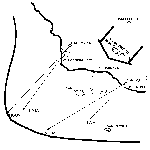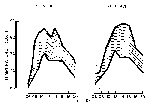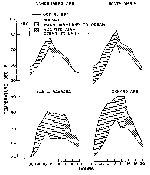
Figure 4: Vandenberg Weather
Click on thumbnail to see full-size image.
SOURCES OF DATA
Radiosonde and wind data from--
.... [AFB A, island A, city A]
Surface weather observations surrounding the times of sightings from--
.... [city B, C, D, E; AFB A, B, C; base D]
GENERAL WEATHER SITUATION
In a weather sequence which moved a trough line and a low pressure center southeastward from northwestern Utah to northwest Texas.... [the day prior to the first sighting], a dome of high pressure formed over the Great Basin and a surge of warm air moved from northeast to southwest.... Most of the surge of warm air moved southwestward from the southern part of the .....Valley between midnight.... [the day before the sighting] and 3:00 P.M. ....[the day of the sighting]. Weather stations near the coast from ....[city B] to ....[city D] all showed abnormally warm temperatures at a time of day when ordinarily a sea breeze would have created a cooling influence.
THE OVER-OCEAN FLOW OF WARM DRY AIR
Using surface wind data from various coastal stations it is possible to reconstruct an approximate pattern of the forward edge of the warm, dry air which moved out over the ocean from a general northeasterly direction. For most stations, fairly strong northeasterly winds were maintained through 11:00 A.M. (see Fig. 4) with northeast winds continuing until 3:00 P.M. at the surface at ....[AFB B].
The upper wind flow from 1000' to 7000' was still from an easterly component at ....[island A] shortly after 3:00 P.M. By 4:00 P.M. air was still moving from an easterly component between 3000' and 10,000' over....[AFB A]. Near the surface westerly winds were beginning to move the warm air back toward the east and southeast. This air had been cooled and some moisture had been added during its stay over the ocean.During most of the afternoon hours the modified air moved from the ocean back over the coastal area. Some of the strongest evidence of the bulge of warm air over the ocean is indicated by the warm, dry air that moved over ....[city D] between the hours of noon and 5:00 P.M. With surface wind directions from 240° through 300°, temperatures held above 80° with maximum of 90°. A portion of the heating of this air would have been caused by dynamic heating as it it moved downslope from the .... mountains.
The abnormality of the warm air is indicated in Figures 5 and 6 by the approximate difference in air temperatures between 6:00 A.M. and 8:00 P.M. The blue profile of normal.... temperature [the date of the first sighting] was made up from long term average maximum and minimum temperatures and an assumed sea breeze influence. The red shaded area indicates the approximate abnormality of warm temperatures on this day as warm, dry air moved from land toward the ocean as compared with typical weather for.... [the date of the first sighting]. The hatched area shows the abnormality remaining after the air had been modified by its path over water.
When warm, dry air is forced to move from a land mass out over cooler
water it creates a narrow boundary of mixing as moisture is picked
up from the ocean developing small turbulent eddies of cooler, more
moist air near the ocean surface. This is accompanied by very rapid
fluctuations of refractive index. At the upper edge of the bulge of
warm, dry air there would be another more difuse boundary where some-
what less sharp differences in both temperature and moisture would be
present. However, there would be corresponding fluctuations in
refractive index.
The Glossary of Meteorology defines a mirage as "a refraction
phenomenon wherein an image of some object is made to appear
displaced from its true position...The abnormal refraction response
for mirages is invariably associated with abnormal temperature
distribution that yield abnormal spatial variations in the refractive
index. Complex temperature distributions produce correspondingly
complex mirages."
The layer of warm, dry air above cooler water from the ocean would
have been particularly conducive to anomalous propagation of any
radar unit scanning the atmosphere at low angles. A somewhat less
important segment of the air mass capable of producing anomalous
propagation on the radar would have been the upper boundary of the
bulge of warm dry air. The following is quoted from Battan's book on
RADAR METEOROLOGY under the heading of Meteorological Conditions
Associated with Non-standard Refraction. "There are various ways that
the index of refraction can be modified to give rise to anomalous
Figure 7 contains the wind and temperature profiles for ....[island
A] and ....[AFB A] beginning with release times of 3:15 P.M. and 4:08
P.M. PST respectively on ....[the date of the first sighting]. At
....[AFB A] (shown by the solid lines of temperature, dew point, wind
direction and velocity) dry air prevailed for all levels above the
surface at: 4:00 P.M. (For the lowest point on the profile,
surface temperatures reported at 7:30 P.M. have been substituted).
The vertical sounding of temperature, dew point, wind velocity and
direction for ....[island A] are indicated by the dashed lines in
Figure 7. Temperatures even warmer
CONCLUSION
It is the author's opinion that the surge of very warm, dry air may
have caused a mirage and visual observations could have been
correspondingly distorted in the vicinity of ....[AFB A] between 7:30
P.M. and 8:30 P.M. It is more certain that the air mass conditions
prevailing over the water continuing through at least midnight in
an arc from south of ....[AFB A] swinging eastward to the coastline
could have produced anomalous propagation echoes on radar. Visibility
observations were generally 12 miles or greater at all stations and
no clouds were reported by the observer at ....[AFB A] between 7:00
P.M. and midnight. ....[base D] reported a few stratus clouds
offshore in the Remarks Column beginning at 7:00 P.M. continuing
through 11:00 P.M.
Evaluation and Conclusions:
Further radar tests. Three days after the first sighting,
under weather conditions similar to the first day but with more wind,
more clouds, and lower temperatures, the FPS-16 radar at....[AFB A]
was operated to determine if similar targets could be seen again.
Targets having the same general characteristics were acquired, but
they were
On the night of the investigators' second visit, similar targets were
acquired on the FPS-16 and TPQ-18 radars. The radar experts among
those present (Blackmer, Brook, Collis, Herold, Lhermitte)
immediately requested that printouts be obtained giving information
on signal strength. This information could not be compared with
earlier sightings because the operators had not taken steps to print
out the data from the other observations.
General conclusions. The AFB A series of sightings is
remarkable for two reasons; first, because of the extraordinarily
high qualifications of the observers, and second, because of the
availability of hard instrument data. No other UFO case in the
records of the Colorado project contains so many numbers,
representing such quantIties as range, azimuth, elevation, and
velocity. Information from which signal strengths could have been
computed also would have been available had the operators thought to
print it out, but they did not. To relate signal strengths and ranges
for these events, it was necessary to go back to the tape of the
conversations and find the reports of signal strengths, which, when
assigned precise times (fortunately, the tape contained good timing
references), could be compared with the printouts of range, which
also included timing references. Information on the visual sightings
was, except for the high credibility of the observers, comparable to
that in other reports of UFO sightings in the Colorado files: i.e.,
no reliably measured quantitative values were available from such
sightings.
Mirage conditions. The detailed weather study by Loren Crow
was not available at the time of the second trip to AFB A, so that it
was not known at that time that the atmospheric conditions were in
fact quite unusual. Fig. 7 of the Crow report indicates that at AFB
A, although return air flow at the surface was well established by
the late afternoon of the original sighting, the flow at 2,000 ft.
was still from the northeast, so that a thin sheet of warm, dry air
lay over the
It should be noted that the incident that set off the entire sequence
of events was an optical sighting at 8:00 p.m. It appears highly
probable that the observer saw the running lights of a ship below the
normal horizon, but made visible as a result of mirage. The
conditions for such a mirage were present, but it must be pointed out
that both the first two witnesses insisted emphatically that the
object appeared at an elevation of about 10°. That is too high
for a mirage of a ship's lights below the horizon. Hence, either
their reports of the elevation angle were incorrect, or some other
explanation must be found. However, even experienced observers tend
to overestimate elevation angles.
A further fact is of interest, and that is that, in the Operations
Control Center on the date of the second visit to AFB A, one of the
operators of a search radar declared that he never saw any ships,
that the shipping lanes were too far off the coast for ships to be
seen by radar from that location, although the antenna was at an
altitude of approximately 1,000 ft. He thereupon switched to his most
distant range (80 mi.) and immediately a sprinkling of blips appeared
at extreme range. They turned out to be ships, their identity
confirmed by their slow speed. Since there is no reason to suppose,
from a quick study of weather conditions that night, that anomalous
propagation had anything to do with the observation of ships, it must
be concluded that they could be seen any time. The only reasonable
explanation of the operator's statement that he never saw ships on
the scope is that
Some of the visual sightings obviously were not of ships. However,
they were impossible to evaluate on the basis of the limited and
subjective descriptions given. In this connection, it is significant
to note the importance of quantitative instrument observations or
records in such investigations. The visual objects could not be
evaluated with much confidence, for lack of definitive evidence; but
abundant quantitative radar records made it possible to identify most
of the radar targets beyond serious doubt.
Birds. The behavior and characteristics of the unidentified
radar targets appeared to be consistent with the hypothesis that most
of them were birds. Individual birds would produce signal strengths
consistent with those observed. (The targets observed the night of
the second visit to AFB A, according to calculations made by Dr.
Lhermitte, yielded a radar cross section of approximately 10
cm.2). The velocities and coherent tracks of the targets
also suggested consistency with the bird hypothesis.
In view of the remarkable inversion conditions on the date of the
original sighting, it is highly probable that some of the
radar targets were effects of anomalous propagation (radar mirages).
Temperature and moisture gradients were quite sufficient to produce
echoes from atmospheric discontinuities.
At first, even the radar experts were puzzled by the radar data,
because the remarkably strong echo signals returned by some of the
targets suggested much larger objects than birds. Their confusion was
resolved when it became apparent from comparisons of range data and
concurrent signal strengths that the very strong signals were always
associated with targets at close range. A radar echo
No attempt had been made during the sightings to associate ranges and
signal strengths. Had someone asked, "When you get an 80-dB signal,
what range do you read?" the evening probably would have ended
differently. Future radar operating procedures might very well
provide that, when unidentified targets are causing concern, ranges
and signal strengths be correlated. Apparently no formal procedure
existed at the time of the sightings for use in identifying unusual
radar targets such as insects, sidelobe echoes, anomalous echoes from
object on the ground, etc. In the absence of such a procedure, the
operators involved in this case handled the situation reasonably.
Comments:
Some comments in a letter from Mr. Collis are particularly pertinent:
I think that the .... incident could be a landmark case in the whole
area of UFO studies. It combines so many factors. Firstly, the
incident involved a whole complex of associated events which were
reported by the most respectable observers. It combined multiple
radar and multiple optical sightings. It occurred very recently and a
substantial amount of recorded, data is available-- i.e., the TPQ 18
radar records and the meteorological data. At least in part, the
radar echo phenomena were repeatable and were observed by
It would seem that most of the inexplicability of the events in this
case (and possibly in many others) arises not from the facts
themselves, (i.e., the specific sightings, etc., at any given
instant) but in the interpretation made and significance attached to
them when they were considered in inappropriate juxtapositions. The
way in which this was done at the time under operational pressures
and even subsequently provided, in my opinion, a most important
object lesson.
It does indeed! The lesson is that the "flap" could have been avoided
if the radar operators had been acquainted with the kinds of targets
they might pick up in search mode, especially during anomalous
atmospheric conditions. It is unlikely that such a "flap" will occur
again at AFB A in such circumstances; but it can happen elsewhere
unless this experience is communicated through appropriate operating
procedures or in some other manner, to other operators of powerful
tracking radars.
Figure 5: Time/Temp Charts
Click on thumbnail to see full-size image.

Figure 6: Time/Temp Charts
Click on thumbnail to see full-size image.
REFRACTION RESPONSE TO WARM, DRY AIR
propagation... When warm, dry air moves over cooler bodies of water,
the air is cooled in the lowest layers, while at the same time mois-
ture is added. In this way strong ducts are produced. These
conditions are frequently found over the Mediterranean Sea as air
blows off the African continent. Extreme anomalous propagation has
been experienced in this region. For example, there have been days
when centimeter radar sets have 'seen' ground targets at ranges of
400-500 miles, even though the horizon was at perhaps 20 miles. In
conformance with meteorological terminology, superrefraction brought
about by the movement of warm, dry air over a cool, moist surface may
be called 'advective superrefraction.' By the nature of the processes
involved, it can be seen that such conditions can occur during either
the day or the night and last for long periods of time. The duration
would depend on the persistency of the glow patterns producing the
advection."

Figure 7: Wind/Temp Profiles
Click on thumbnail to see full-size image.
than over ....[AFB A] were reported in the ascent above ....[island
A]. For emphasis, the area shaded in red indicates how much warmer
the temperatures were over ....[island A] than at ....[AFB A] during
the mid-afternoon hours. Ocean water temperatures between 58° and
59° were being reported, which is considerably cooler than the
warm, dry air having temperature in the 80's as it moved from land to
over the water.
design on subsequent occasions. It was sufficiently strange to cause
interceptor aircraft to be sent off to investigate it in the heat of
the moment, and also to cause the local and visiting experts
considerable perplexity even in the cool light of day. We thus have a
wonderful opportunity not only to study the physical nature of the
incident but also to study the psychological implications of such
incidents.
